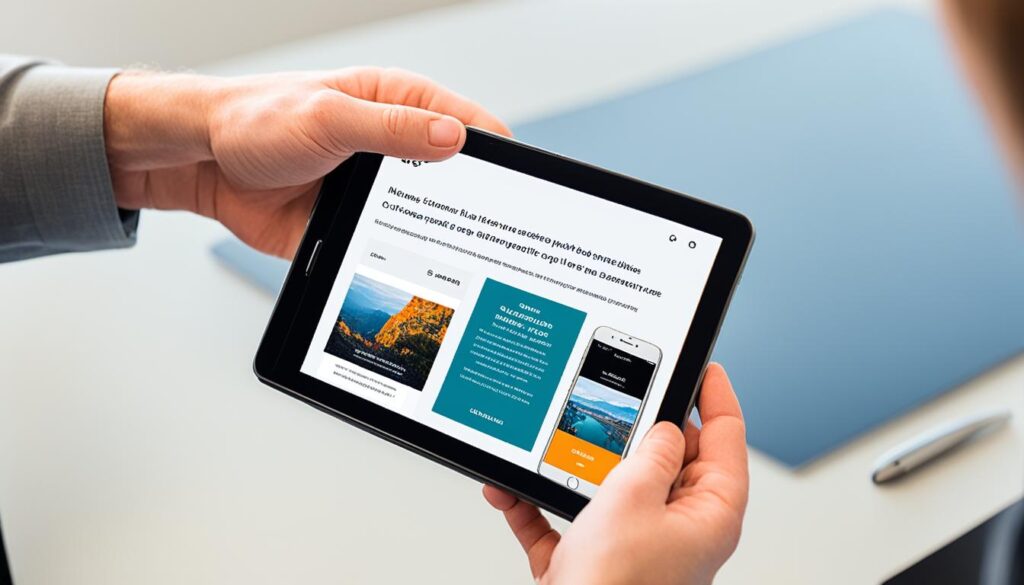In today’s technological era, mobile devices play a crucial role in our daily lives. It may come as a surprise to learn that over half of all website traffic comes from mobile sources. The majority of internet users actually access the web through their smartphones and tablets. This significant data underscores the necessity of optimizing your website for mobile devices, enhancing its mobile responsiveness to improve search engine rankings and ensure a smooth user experience.
- Mobile optimization is crucial for improved search rankings
- A mobile-friendly website is essential for a positive user experience
- Responsive design and mobile-first indexing are key factors in mobile SEO
- Website performance and speed are critical for mobile optimization
- Optimizing for mobile can enhance overall user experience
What is Mobile SEO?
Mobile SEO, or search engine optimization, refers to the process of optimizing your website for mobile devices in order to improve its visibility in mobile search results and enhance the user experience. With the increasing use of mobile devices for internet browsing, it’s crucial for businesses to prioritize mobile optimization to reach their target audience effectively.
When it comes to mobile SEO, there are several key factors to consider. First and foremost, a mobile-friendly website is easily understood by search engines, ensuring that your content is properly indexed and displayed in search results. Additionally, a mobile-optimized website loads quickly on mobile devices, providing a seamless browsing experience for users.
Mobile SEO also focuses on ensuring that your website displays properly and is easy to navigate on mobile devices. This involves using responsive design techniques to adapt your website’s layout to different screen sizes and orientations. Responsive design allows your website to automatically adjust its appearance based on the device being used, ensuring that your content is accessible and readable on any mobile device.
Furthermore, mobile SEO emphasizes the importance of creating value for mobile users. It’s essential to provide relevant and engaging content that meets the needs of your mobile audience. By understanding the search intent of mobile users and tailoring your content to their preferences, you can improve the overall user experience and drive more traffic to your website.
Overall, mobile SEO is crucial for businesses looking to enhance their online visibility and reach their target audience on mobile devices. By optimizing your website for mobile, you can improve its visibility in mobile search results and provide a seamless user experience, ultimately driving more traffic and boosting your online presence.
The Importance of Mobile SEO
Mobile SEO plays a crucial role in digital marketing today. With the majority of searches now performed on mobile devices, it is essential to optimize your website for mobile users. Additionally, Google places great emphasis on providing a seamless mobile experience, and smartphones are dominating the realm of voice search. Therefore, prioritizing mobile SEO is key to improve your search rankings and cater to the preferences of modern users.
First and foremost, the rise of mobile devices has transformed the way people search for information. Whether it’s browsing for products, researching services, or seeking answers to their queries, users are reaching for their smartphones. As a result, having a mobile-friendly website ensures that you can capture and retain this expanding mobile audience, driving valuable organic traffic to your site.
Google, the leading search engine, recognizes the importance of mobile optimization and rewards websites that offer a seamless mobile experience. By providing a smooth and responsive browsing experience on mobile devices, you can enhance user satisfaction, decrease bounce rates, and increase user engagement. These positive signals are crucial for improving your website’s visibility and search rankings.
“A mobile-friendly website not only caters to the preferences of mobile users but also aligns with Google’s search preferences, giving you an edge in the competitive digital landscape.”
Furthermore, the rise of voice search has revolutionized how users interact with search engines. With the increasing adoption of virtual assistants like Siri, Google Assistant, and Amazon Alexa, voice search has become an integral part of everyday life. Optimizing your website for mobile can significantly improve your chances of ranking well in voice search results. By aligning your content with user intent and incorporating conversational keywords and phrases, you can enhance your visibility in voice search queries.
Table: Mobile SEO Benefits
| Benefits | Explanation |
|---|---|
| Improved search rankings | Enhancing mobile SEO can boost your website’s visibility in search engine results pages, driving organic traffic and increasing brand exposure. |
| Enhanced user experience | A mobile-friendly website provides a seamless browsing experience, leading to higher user satisfaction, longer session durations, and increased conversions. |
| Higher voice search rankings | Optimizing for mobile can significantly improve your website’s chances of ranking well in voice search queries, attracting voice search traffic. |

By recognizing the importance of mobile SEO, you can take advantage of the growing mobile user base, meet Google’s search preferences, and optimize for voice search. These actions will contribute to higher search rankings, increased organic traffic, and improved user engagement, ultimately leading to greater success in the mobile-driven digital landscape.
Google’s Mobile-First Indexing
Google’s mobile-first indexing is a significant development in the world of SEO. With the increasing prevalence of mobile devices, Google has taken steps to prioritize mobile-friendly websites in search rankings. This change reflects the shift in user behavior, as more and more people use their smartphones to browse and make online purchases.
Mobile-first indexing means that Google uses the mobile version of a website for indexing and ranking purposes. This means that if your website is not optimized for mobile, it may rank lower in search results, resulting in decreased visibility and, ultimately, fewer visitors to your site.
Google has implemented several updates over the years to promote mobile optimization. For example, they have started labeling websites as “mobile-friendly” in search results, making it easier for users to find websites that are compatible with their devices. Additionally, sites that provide a poor mobile experience may be penalized in terms of rankings.
One of the key ranking signals for mobile search results is website speed. Google recognizes that users expect fast-loading pages when browsing on their mobile devices, and they prioritize websites that deliver a seamless and efficient experience. Therefore, it is crucial to optimize your website’s speed for mobile users.
Image:

By ensuring that your website meets Google’s mobile-friendly criteria and providing a fast and optimized mobile experience, you can improve your rankings in mobile search results.
In the next section, we will share valuable tips to help you improve your website’s mobile SEO and boost your rankings even further.
Mobile SEO Tips to Improve Your Rankings
Optimizing your website for mobile devices is crucial for improving its rankings in search results. To help you optimize your website for mobile SEO, we have compiled a list of essential tips:
- Confirm that your site is mobile-friendly: Ensure that your website is designed and optimized to provide a seamless user experience on mobile devices. Use Google’s mobile-friendly test and Google Console to check if your site meets mobile-friendly criteria.
- Improve site speed: Website performance is a critical factor for mobile SEO. Optimize your site’s speed by compressing and optimizing images, minimizing HTTP requests, and enabling browser caching and Gzip compression.
- Make your design responsive: A responsive design allows your website to adapt to different screen sizes, providing an optimal viewing experience for mobile users. Use breakpoints and media queries to ensure that your design is mobile-friendly.
- Optimize images and visual assets: Compress and optimize images to reduce their file size without compromising quality. Use descriptive alt text for images to improve accessibility and keyword relevance.
- Understand search intent: To optimize your website’s content for mobile, it is crucial to understand the search intent of mobile users. Create content that aligns with their needs and provides valuable information.
- Optimize your website’s architecture: Ensure that your website’s structure is logical and easy to navigate on mobile devices. Use clear and concise headings, organize content into sections, and improve internal linking.
By following these mobile SEO tips, you can optimize your website for mobile devices and improve its rankings in search results. Remember to consistently monitor and analyze your website’s performance to stay ahead of the competition.
“Optimizing your website for mobile devices is crucial for improving its rankings in search results.”
Check out the table below for a comparison of the key factors to consider when optimizing your website for mobile SEO:

| Optimization Factor | Mobile-Friendly Design | Site Speed | Responsiveness | Image Optimization | Search Intent | Website Architecture |
|---|---|---|---|---|---|---|
| Importance | High | High | High | Medium | Medium | Medium |
| Benefits | Improved user experience, better rankings | Reduced bounce rate, increased conversions | Optimal viewing experience on all devices | Faster load times, improved accessibility | Alignment with user needs, increased engagement | Easier navigation, better user experience |
| Considerations | Responsive design, mobile-friendly test | Image optimization, caching, compression | Breakpoints, media queries | Compression, alt text, file size reduction | Keyword research, content optimization | Clear headings, organized structure, internal linking |
Confirm That Your Site Is Mobile Friendly
Ensuring that your website is mobile-friendly is essential for providing a seamless user experience and improving your search rankings. Google offers valuable tools to help you confirm the mobile-friendliness of your site.
Mobile-Friendly Test
Google’s Mobile-Friendly Test is a quick and easy way to determine if your website is optimized for mobile devices. Simply enter your website URL, and the test will analyze your site’s mobile usability.
“Having a mobile-friendly website is crucial for engaging mobile users and enhancing your online presence.”
If your site passes the test, you can rest assured that it meets Google’s mobile-friendly criteria. However, if your site doesn’t pass, you’ll receive recommendations on how to improve its mobile usability.

Google Console
Another valuable tool provided by Google is Google Console. It allows you to monitor and manage your site’s presence in Google search results. Within Google Console, you can access the Mobile Usability report, which provides insights into any issues that may affect your site’s performance on mobile devices.
By regularly checking the Mobile Usability report, you can identify and resolve any mobile usability issues promptly, ensuring that your website remains accessible and user-friendly across all devices.
Optimizing Content Formats
When optimizing your website for mobile, it’s crucial to consider all content formats, including videos, images, and text. Ensure that all these formats are crawlable and indexable by search engines to maximize your site’s mobile usability and search visibility.
“Optimizing your website for voice search and using alt attributes for images are effective strategies to enhance mobile usability and search visibility.”
Additionally, optimizing your content for voice search can help your website rank higher in mobile search results, as voice search continues to grow in popularity.
When using images on your site, be sure to include descriptive alt attributes. Alt attributes not only improve accessibility for visually impaired users but also provide additional keywords for search engines to understand your images better.
Overall, by using Google tools, optimizing content formats, and ensuring mobile usability, your website will be well-positioned to provide an excellent user experience on mobile devices and improve its search rankings in the competitive digital landscape.
Improve Your Site Speed
Site speed plays a critical role in mobile SEO. Slow-loading pages can result in higher bounce rates and negatively impact conversions. Optimizing your site speed is essential to provide a smooth user experience and achieve better rankings in mobile search results. Here are some effective techniques to enhance your site speed:
- Compress and optimize images: By reducing the size and optimizing the format of your images, you can significantly improve load times. Use image compression tools and ensure images are appropriately scaled for mobile devices.
- Minimize HTTP requests: Reduce the number of requests made to the server by combining or eliminating unnecessary files, such as stylesheets and scripts. This helps to decrease load times and improve overall performance.
- Minify CSS and JavaScript files: Remove unnecessary characters and spaces from your CSS and JavaScript files, reducing their file size and improving load times.
- Enable asynchronous loading: Enable asynchronous loading of scripts to prevent them from blocking the rendering of your web pages. This allows your content to load faster and improves the user experience.
- Upgrade your web hosting: Consider upgrading to a faster and more reliable web hosting provider to ensure your site is served quickly to users.
- Enable browser caching: Implement browser caching to store static resources, such as images and CSS files, on the user’s device. This reduces the need to fetch these resources repeatedly, improving load times.
- Enable Gzip compression: Compress your website’s files using Gzip compression to reduce their size and improve load times. This technique is particularly effective for text-based files, such as HTML, CSS, and JavaScript.
By implementing these site speed optimization techniques, you can significantly enhance the performance of your website on mobile devices, providing a seamless user experience that boosts your mobile SEO rankings.

Why Site Speed Matters
“A one-second delay in mobile load times can impact conversion rates by up to 20%.” – Google
Site speed is a crucial factor in delivering a positive user experience and improving mobile SEO. In today’s fast-paced digital world, users expect websites to load quickly and seamlessly on their mobile devices. Slow-loading pages can frustrate users, leading to higher bounce rates and a negative perception of your brand.
Furthermore, search engines, including Google, consider site speed as a ranking factor for mobile search results. Websites that load quickly are more likely to rank higher in search engine results, improving visibility and organic traffic to your site.
Optimizing your site speed not only benefits your mobile SEO efforts but also enhances user satisfaction and overall website performance. By prioritizing site speed, you can create a positive user experience that keeps visitors engaged and increases the likelihood of conversions.
Make Your Design Mobile Responsive
A responsive design is essential for optimizing your website for mobile users and delivering an outstanding user experience. With the increasing number of people accessing the internet on mobile devices, it’s crucial to ensure that your website is accessible and visually appealing on different screen sizes.
By implementing a responsive design, you can:
- Adapt your website to various devices
- Provide an optimal viewing experience for mobile users
- Improve usability and navigation
- Increase engagement and reduce bounce rates
- Boost your mobile SEO rankings
To achieve a mobile-responsive design, consider the following techniques:
- Scaling images for mobile users: Ensure that images are appropriately sized and optimized for mobile devices. This will help to improve page load speeds and prevent oversized images from slowing down your site.
- Using breakpoints and media queries: Define breakpoints in your CSS code, which allow your website to adapt its layout based on different screen sizes. Media queries enable you to apply specific styles and properties to certain devices or screen resolutions.
- Ensuring content is easily readable and accessible: Optimize your font sizes, line spacing, and paragraph lengths for improved readability on smaller screens. Use clear and legible fonts that are accessible across different devices and operating systems.
Benefits of a Mobile-Responsive Design:
“A mobile-responsive design improves user experience and helps boost mobile SEO rankings.” – Google
A mobile-responsive design not only enhances the user experience but also improves your website’s visibility and performance. It allows visitors to have a consistent and seamless browsing experience, regardless of the device they use. By catering to the needs of mobile users, you can increase engagement, drive conversions, and ultimately achieve better results for your business.

| Benefits of a Mobile-Responsive Design | Mobile-Responsive Design |
|---|---|
| User Experience | Delivers optimal viewing experience on any device |
| Search Engine Ranking | Improves mobile SEO rankings |
| Usability | Enhances website navigation and accessibility |
| Engagement | Reduces bounce rates and increases user engagement |
Create Mobile-Friendly Content
When it comes to mobile optimization, creating mobile-friendly content is key. By adopting specific formatting and structuring techniques, you can enhance readability, improve user experience, and make your content visually appealing on mobile devices.
Short Paragraphs and Sentences: Breaking your content into short paragraphs and sentences makes it easier for mobile users to scan and digest information. This improves readability and keeps readers engaged.
Headers and Subheadings: Use headers and subheadings to organize your content and guide readers through different sections. This not only improves readability but also helps users navigate your content more efficiently.
Bullet Points and Numbered Lists: Incorporate bullet points and numbered lists to present information in a concise and scannable format. This allows mobile users to quickly grasp key points and improves the overall user experience.
Images and Visual Elements: Including relevant images and visual elements in your content can enhance engagement and captivate mobile users. Visuals break up text-heavy pages and make the content more visually appealing.

Effective Use of White Space: Utilizing white space or empty areas on your webpage can make your content more readable and visually appealing. By giving your content room to breathe, you create a cleaner and less cluttered mobile experience.
“Incorporating these formatting techniques into your mobile content not only improves readability but also enhances user experience. Mobile users value content that is easy to consume, visually appealing, and provides valuable information.”
Mobile-Friendly Content Formatting Checklist:
| Formatting Techniques | Benefits |
|---|---|
| Short paragraphs and sentences | Improved readability and engagement |
| Headers and subheadings | Enhanced content organization and navigation |
| Bullet points and numbered lists | Concise and scannable presentation of information |
| Images and visual elements | Increased engagement and visual appeal |
| Effective use of white space | Cleaner and less cluttered mobile experience |
By implementing these formatting techniques, you can optimize your content for mobile devices, ensuring mobile-friendly content that enhances readability, user experience, and overall engagement.
Optimize Title Tags and Meta Descriptions
Optimizing title tags and meta descriptions is crucial for improving click-through rates and attracting visitors to your website. By crafting compelling and well-optimized titles and descriptions, you can enhance search visibility, increase user engagement, and drive more traffic to your site.
Target Keywords
When optimizing your title tags and meta descriptions, it’s important to include relevant target keywords. These keywords should align with the search intent of your target audience and accurately represent the content of the page.
Engaging and Descriptive Titles
Your title tags should be engaging and descriptive, capturing the attention of users and enticing them to click. Use compelling language, highlight the main benefit or value proposition of your content, and keep the title concise and easy to read.
“Crafting captivating titles is an art form. By leveraging power words and sparking curiosity, you can draw visitors in and increase your click-through rate.”
Compelling Meta Descriptions
Your meta descriptions should provide a summary of the page’s main benefit or value proposition. They should be concise, clear, and persuasive, compelling users to click and learn more. Including a call to action can also increase click-through rates and drive user engagement.
Testing and Optimization
It’s important to test and optimize your title tags and meta descriptions to maximize their effectiveness. Monitor your click-through rates and make adjustments based on performance data. Experiment with different variations and analyze the results to identify what resonates best with your audience.
Key Takeaways:
- Include relevant target keywords in your title tags and meta descriptions.
- Create engaging and descriptive titles that capture attention.
- Write compelling meta descriptions that summarize the page’s main benefit.
- Experiment, test, and optimize for better search visibility and user engagement.

| Benefits | Actions |
|---|---|
| Improved click-through rates | Include relevant keywords Write engaging titles Compose compelling meta descriptions |
| Increased search visibility | Optimize titles and descriptions Test variations Analyze performance data |
| Enhanced user engagement | Create clear and persuasive descriptions Add compelling calls to action Monitor click-through rates |
Conclusion
In conclusion, implementing mobile optimization techniques is vital for improving search rankings and enhancing the overall performance of your website. By prioritizing mobile SEO, you can ensure a positive user experience and improve search visibility for mobile devices.
By following best practices such as having a mobile-friendly website, optimizing site speed, using responsive design, creating mobile-friendly content, and optimizing title tags and meta descriptions, you can effectively optimize your website for mobile devices. This will not only improve search rankings but also provide a seamless and enjoyable browsing experience for your users.
Remember that with mobile devices accounting for a significant portion of web traffic, it is essential to stay competitive in the digital landscape by prioritizing mobile optimization. By focusing on mobile SEO and ensuring that your website performs well on mobile devices, you will be able to reach a wider audience, gain improved search rankings, and deliver a superior user experience.
FAQ
What is mobile SEO?
Mobile SEO refers to the process of optimizing your website for mobile devices to improve its visibility in mobile search results and enhance the user experience.
Why is mobile SEO important?
Mobile SEO is important because a majority of searches are now performed on mobile devices, Google prioritizes websites that provide a seamless experience on mobile, and smartphones are dominating voice searches.
What is Google’s mobile-first indexing?
Google’s mobile-first indexing prioritizes mobile-friendly websites in search rankings, ensuring that websites that are optimized for mobile devices rank higher in mobile search results.
How can I improve my website’s rankings in mobile search results?
You can improve your website’s rankings in mobile search results by confirming that your site is mobile-friendly, improving site speed, making your design responsive, optimizing images and visual assets, understanding search intent, and optimizing your website’s architecture.
How can I confirm if my website is mobile-friendly?
You can use tools such as the mobile-friendly test and Google Console to check if your website meets Google’s mobile-friendly criteria.
Why is site speed important for mobile SEO?
Site speed is crucial for mobile SEO because slow-loading pages can lead to increased bounce rates and negatively impact conversions.
How can I improve site speed for mobile SEO?
You can improve site speed for mobile SEO by compressing and optimizing images, minimizing HTTP requests, minifying CSS and JavaScript files, enabling asynchronous loading, upgrading web hosting, and enabling browser caching and Gzip compression.
How can I make my website design mobile responsive?
You can make your website design mobile responsive by scaling images for mobile users, using breakpoints and media queries, and ensuring that content is easily readable and accessible on different screen sizes.
How can I create mobile-friendly content?
You can create mobile-friendly content by structuring your content with short paragraphs and sentences, using headers and subheadings, incorporating bullet points and numbered lists, utilizing images and visual elements, and making effective use of white space.
How can I optimize my title tags and meta descriptions for mobile SEO?
You can optimize your title tags and meta descriptions for mobile SEO by including target keywords, making titles engaging and descriptive, writing compelling meta descriptions that summarize the page’s main benefit, and testing and optimizing these elements to improve search visibility and user engagement.










